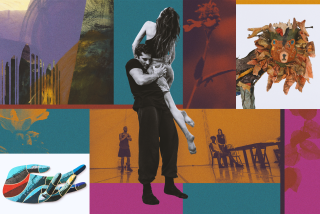Dance : Three Indian Forms in One in Long Beach
Onstage at the Long Beach Terrace Theater on Saturday, three forms of classical Indian dance share a joyous invocation: the same rhythmic patterns and even step sequences interpreted in three distinctive movement languages.
Viji Prakash embodies the dynamism of Bharata Natyam, an idiom in which the hands shoot away from the body on sharp, arrowy paths and create a kinetic sunburst around the dancer. In contrast, Nandita Behera represents the sinuousness of Odissi, in which curving, tendril arms delicately wreathe the body and ornament its contours. Finally, Chitresh Das defines the percussive acuity of Kathak, in which the arms flash like lightning, left and right, as bare feet and ankle bells make music against the floor.
After this inspired collaboration, these major artists will separate and be absorbed into dance-drama: the biography of Meera Bai, poet-saint of 16th-Century Rajasthan. Das will reappear as two family oppressors, adding an edge of contemptuous fury to the formal rhythmic structures of Kathak performance--and, along the way, displaying his trademark, a tornado of 27 whiplash turns-in-place. Behera will return in a dream sequence as Radha (beloved of the god Krishna), portraying the character’s yearning with immediacy while coiling herself into sculptural poses carved centuries ago.
Each interacts with Prakash, cast as Meera and responsible for most of the solo dancing in a nearly four-hour production. Her energy never flags, and she proves amazingly resourceful in detailing the growing maturity and spiritual depth of the character. However, in the end, the narrative doubles back on itself too many times to maximize the impact of her performance.
In life, Meera Bai’s uncompromising devotion to Krishna put her continually at risk but created a body of poems still widely known and loved. On stage, “Meera” begins inventively by telescoping her childhood, adolescence and early adulthood into a choreographic time-line shared by Prakash and two young members of her dance company. Unfortunately, it soon turns dogged in the depiction of a repetitive sequence of events: Meera spurned at home, finding fulfillment in her wanderings and being pressured to come back.
Some of the miracles that sustained Meera are transformed into potent choreography, but others are literally acted out, pageant style, with the final one especially weak in its staging. Ultimately, what started as a dance-poem about union with the divine becomes fatally overburdened with conflicting approaches and diversionary spectacle--at least for those English-speaking spectators who cannot understand the sung Meera Bai texts.
However, since the singer of those texts is most often the exquisitely soulful Lakshmi Shankar, they prove eloquent despite any language barrier. Heading two ensembles of distinguished musicians (one playing in the Karnatic style of South India, the other in the Hindustani style of the North), Shankar never lets us forget that “Meera” is the story of a woman consumed with love for her god. In an evening honoring historical miracles, she creates a new one of her own in the middle of the orchestra pit.
More to Read
The biggest entertainment stories
Get our big stories about Hollywood, film, television, music, arts, culture and more right in your inbox as soon as they publish.
You may occasionally receive promotional content from the Los Angeles Times.










